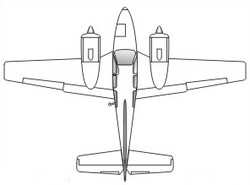Despite Tort "Reform,"The Legal System Isn't Getting Any Less
Strange...
 While the statute of
repose was supposed to minimize legal exposure for long suffering
aviation businesses, it seems that the legal profession still knows
how to extract a lot of money from this business... even when the
facts don't seem to support that effort.
While the statute of
repose was supposed to minimize legal exposure for long suffering
aviation businesses, it seems that the legal profession still knows
how to extract a lot of money from this business... even when the
facts don't seem to support that effort.
Local news reports state that Teledyne Continental Motors has
just been clobbered for the princely sum of $4 million bucks.
Robert Young was killed in a Beech Baron accident in January of
2002 while reportedly scud-running under a 500 foot overcast.
The family of the Monroe, LA businessman reportedly claimed that
the TCM powerplants (that were apparently not covered by the
statute of repose, as the left and right 260-horsepower Continental
IO-470-L (21) engines were factory remanufactured and zero timed in
October 1995 and June 1996, respectively) were the cause of the
accident -- an argument successfully put forth by local counsel(s)
Daniel Barks, Richard Fewell Jr. and Dion Young, during a week-long
legal case. Young, 57, was the only person on board the aircraft
when it went down and was killed on impact, while trying to work
his way home in poor weather from a hunting camp in Arkansas.
The trial apparently (and deliberately, it appears) tugged at
the emotions of the jury, and local news reports indicated that the
lawyers even brought in Young's Pastor to testify in the case
-- though we're not sure what kind of value such a person brings to
a suit in which the facts surrounding the cause of the accident are
supposed to be the sole determining factor.
Be that as it may, the reason this matter strikes ANN as a
little 'off' is simply this: the NTSB report does NOT report an
engine failure as the cause of the accident... and it appears that
both powerplants were operating at the time of the accident. Mind
you; NTSB conclusions are not allowed to be used in such court
actions... ostensibly in order to maintain some proper separation
between the governmental functions of the accident investigation
process and the civil actions that may result (and let's face it,
the Trial Lawyers like it that way). At the same time... for a
process that is designed and promoted around the world as the means
to seek a fair and impartial determination of fact and cause... it
seems foolish, if not downright Un-American, to exclude ANY fact
that can have a bearing in finding the root cause of such a tragedy
-- especially when those facts come from the most expert source in
the world on such matters.
 According to the NTSB
Probable Cause Report #FTW02FA062, issued 4/1/2003, the Board found
that N77RY, a Beech 95-B55, went down due to "the pilot's failure
to maintain control of the airplane while maneuvering resulting in
an inadvertent stall/spin." The report summarized the tragedy
by noting that, "A witness stated that he heard the airplane over
fly the private airport at what sounded like a "low altitude." The
witness went outside and observed the airplane approximately 1/4 of
a mile southeast, at 300 feet above the ground, in a steep left
bank. The airplane entered a spin, rotated 1-1.5 times, and
impacted the ground. The witness reported that the cloud base was
approximately 500 feet agl. On the day prior to the accident date,
the instrument-rated pilot flew the airplane to a private ranch.
Concerned with the deteriorating weather conditions, the pilot
elected to depart the ranch one day earlier than he had planned,
then return to the ranch via his vehicle. Prior to departure, the
pilot obtained a weather briefing and visual flight rules (VFR) was
not recommended for his route of flight. The pilot purchased the
airplane in August 1994, and reported on an insurance form, dated
May 14, 2001, that he accumulated 1,081 flight hours in the
accident airplane make and model. Examination of the airplane and
engines revealed no evidence of any pre-impact discrepancies."
According to the NTSB
Probable Cause Report #FTW02FA062, issued 4/1/2003, the Board found
that N77RY, a Beech 95-B55, went down due to "the pilot's failure
to maintain control of the airplane while maneuvering resulting in
an inadvertent stall/spin." The report summarized the tragedy
by noting that, "A witness stated that he heard the airplane over
fly the private airport at what sounded like a "low altitude." The
witness went outside and observed the airplane approximately 1/4 of
a mile southeast, at 300 feet above the ground, in a steep left
bank. The airplane entered a spin, rotated 1-1.5 times, and
impacted the ground. The witness reported that the cloud base was
approximately 500 feet agl. On the day prior to the accident date,
the instrument-rated pilot flew the airplane to a private ranch.
Concerned with the deteriorating weather conditions, the pilot
elected to depart the ranch one day earlier than he had planned,
then return to the ranch via his vehicle. Prior to departure, the
pilot obtained a weather briefing and visual flight rules (VFR) was
not recommended for his route of flight. The pilot purchased the
airplane in August 1994, and reported on an insurance form, dated
May 14, 2001, that he accumulated 1,081 flight hours in the
accident airplane make and model. Examination of the airplane and
engines revealed no evidence of any pre-impact discrepancies."
The expanded narrative specifically cast doubt on any issues
with a potential powerplant failure with an analysis of the
powerplants, post-impact. "On February 20 and 21, 2002, at the
Teledyne Continental Motors facility in Mobile, Alabama, under the
supervision of an NTSB investigator, the left and right engines
were examined. The inspection and disassembly of the engines and
related components did not reveal any discrepancies that would have
precluded operation prior to the accident. The fuel system
components were examined and flow bench tested. During the right
engine fuel pump flow test, there was no flow at the fuel pump
vapor ejector. The ejector fitting was removed, and it was
determined that the vapor ejector contained a foreign object that
was consistent with black rubber. The vapor ejector was replaced,
and no anomalies were noted with the flow test. The fuel pump was
disassembled, and no contamination was found inside the fuel pump
components. The source of the black rubber debris was not
determined. To simulate a blocked fuel pump vapor ejector, an
exemplar engine was run in a production test cell with the vapor
ejector fitting capped. The engine startup and engine run to 2,000
RPM were performed with no anomalies noted."

The NTSB witness reports told an equally intriguing story.
"According to local law enforcement officials, on January 4, 2002,
approximately 0630, the pilot flew the accident airplane from
Monroe to a private hunting ranch near Avon. The pilot was
scheduled to return from the ranch on January 6, 2002. According to
one of the family members, the pilot was concerned with the
deteriorating weather conditions and elected to fly his aircraft
back to Monroe before the weather got worse. The pilot then was
going to drive his truck back to the ranch. Two witnesses, who were
traveling in a vehicle on state highway 585 reported that they
observed the "brown twin-engine plane" as it crossed the highway.
The airplane was traveling in a southwest direction, and they
'notice[d] the unusual position of the plane flying. The manner in
which it was flying looked sideways...The altitude look[ed] approx.
200-300 ft.'"

A witness, who was located north of the private Costello Airport
(2LA7) north of Oak Grove, reported that approximately 1000, he
heard the plane fly over his house and stepped outside of the house
to see who it was. He observed the 'Baron flying south at app. 300
- 350 ft above the ground. The wings were level. It was flying at
reasonable speed. I thought it was Costello's Baron. I was curious
to know why he was flying so low.'"
Another witness, who was located in an office at the Costello
Airport, stated that he heard the airplane over fly the airport at
what sounded like a 'low altitude.' The witness went outside and
observed the airplane approximately 1/4 of a mile southeast of the
airport, at 300 feet agl, in a steep left bank. The airplane then
entered a spin, rotated 1-1.5 times and impacted the ground. The
witness reported that the cloud base was approximately 500 feet
agl."
ANN E-I-C Summary: So... there you have
it... no NTSB evidence of an engine failure, a pilot flying at very
low altitude under a low ceiling and a steep turn to head back to a
runway that could not have been all that easy to find in light of
the meteorological issues, followed by the NTSB's determination of
a stall/spin... and TCM gets to pay $4 million dollars. Is there
any doubt as to why aviation continues to be so expensive and
embattled when judgments like this are rendered with (apparently)
little or no authoritative/supporting evidence? Hmmmmm... -- Jim
Campbell, ANN E-I-C.
 ANN's Daily Aero-Linx (05.06.25)
ANN's Daily Aero-Linx (05.06.25) ANN's Daily Aero-Term (05.06.25): Ultrahigh Frequency (UHF)
ANN's Daily Aero-Term (05.06.25): Ultrahigh Frequency (UHF) ANN FAQ: Q&A 101
ANN FAQ: Q&A 101 Classic Aero-TV: Virtual Reality Painting--PPG Leverages Technology for Training
Classic Aero-TV: Virtual Reality Painting--PPG Leverages Technology for Training Airborne 05.02.25: Joby Crewed Milestone, Diamond Club, Canadian Pilot Insurance
Airborne 05.02.25: Joby Crewed Milestone, Diamond Club, Canadian Pilot Insurance






